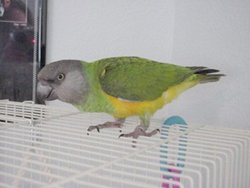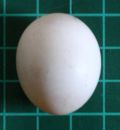Senegal Parrot
Conservation status Least concern |

|
|
Scientific classification |
| Kingdom: |
Animalia
|
| Phylum: |
Chordata
|
| Class: |
Aves
|
| Order: |
Psittaciformes
|
| Family: |
Psittacidae
|
| Tribe: |
Psittacini
|
| Genus: |
Poicephalus
|
| Species: |
P. senegalus
|
|
|
Binomial name |
Poicephalus senegalus
Linnaeus, 1766 |

Senegal parrot egg (on 1cm grid)
The Senegal Parrot (Poicephalus senegalus)
is a
parrot which is a resident breeder in west Africa. It
undergoes local movements, driven mainly by the availability of
the fruit and blossoms which make up its diet. It is
considered a farm pest, often feeding on crops.
The Senegal Parrot is a bird of open woodland and
savannah. It nests in holes in trees, often
Oil Palms, laying 2-3 white eggs. The eggs are about 3cm
long x 2.5cm wide. It is a gregarious species, continuously
chattering with a range of whistling and squawking calls.
Senegal Parrots live an average of approximately 25-30 years
in the wild, but have been known to live for 50 years in
captivity.
The Senegal Parrot is about 23 cm long, plump-looking,
and weighs about 125 to 170 gm. Males are generally larger
and heavier then female birds. Adults have a charcoal grey
head, yellow eyes, green back and throat, and yellow
underparts and rump. The yellow and green areas on a Senegal
Parrot's front form a V-shape and resemble a yellow vest
worn over green. Immature birds are duller, with a lighter
grey head and grey eyes. Senegals are not
sexually dimorphic, but there are some hypotheses on how
to tell the genders apart; it is thought that a female's
beak and head are smaller and narrower than the male's and
also, the V-shape of the vest is usually longer in females,
so that the green area extends down over the chest to
between the legs whereas in males it ends midway down the
chest.
There are three generally recognized subspecies. They do
not differ in behaviour, but only in the color of the
"vest". In the pet trade, the nominate subspecies is the
most common though all three are raised and sold as pets.
- Poicephalus senegalus senegalus (the nominate
subspecies): The vest is yellow. Its native range
includes southern
Mauritania, southern Mali to Guinea and the Island of
Los.
- P. s. mesotypus: This subspecies has an
orange vest. It comes from eastern and northeastern
Nigeria and Cameroon into southwest Chad.
- P. s. versteri: The vest of this subspecies
is red. Its native range is the Côte d'Ivoire and Ghana
east to western Nigeria.
Senegal Parrots as pets
The Senegal Parrot has recently begun to be bred in
captivity and is the most popular Poicephalus parrot in
aviculture, with the Meyers Parrot being the second most popular. They can
live up to 40 or 50 years in a safe clean home. They eat
seeds, most fruits and vegetables.
Hand reared Senegal Parrots make excellent pets, and,
like all Poicephalus parrots, they are curious,
fun-loving animals that are much "mellower" compared with
many other parrots. They are acrobatic, amusing, and
generally sweet. They are able to speak in a limited
fashion, often with a high squeaky voice, and can learn to
mimic many sounds such as whistling, kisses, microwave
beeps, and smoke alarms. They do not make very loud noises,
like some parrots do. They are known for their jealousy of
other family members and pets. They can develop a bond with
only one human and refuse to interact with other people,
even attacking them in some cases. Although a Senegal is a
small bird it does not seem to believe so, and will attack
larger birds and even dogs if it feels it or its human is
threatened. Owners should be cautious in multiple-pet homes.
Continuing to socialize the hand reared pet bird from a
young age and letting many people handle and interact with
it can prevent single-person bonding and allow it to become
an excellent family pet.
Wild-caught Senegal Parrots do not make good pets,
because they do not become tame and they will always be
frightened of humans. The Convention on the International
Trade in Endangered Species (CITES)
has made the trade of wild caught parrots illegal.
Gallery
References
- BirdLife International (2006).
Poicephalus senegalus. 2006 IUCN Red List of
Threatened Species. IUCN 2006. Retrieved on 09 May 2006.
- Birds of The Gambia by Barlow, Wacher and
Disley,
ISBN 1-873403-32-1
-
SENEGAL Parrot. Retrieved on
September 20, 2005.




